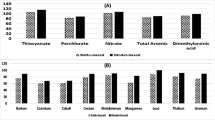Summary
The values of biological indicators used in biological monitoring are usually determined on spot samples of urine. In order to reduce the variations due to dilution, it is common practice to correct the values according to reference parameters, such as urinary creatinine concentration and specific gravity. The aim of the present study was to verify whether creatinine possesses the necessary characteristics for adjustment. The levels of creatinine were not influenced by diuresis, but, contrary to what was expected, the values of the metabolite showed marked intra- and interindividual variations. These data raise serious doubts as to the validity of creatinine as a parameter that can be used for adjustment purposes, and suggest that it would be advisable to ascertain for each biological indicator whether in fact adjustment is of any use. Lastly, since there was only a slight correlation between creatinine levels and specific gravity values, it is concluded that these two parameters cannot be used indifferently for adjustment.
Similar content being viewed by others
References
Araki S (1978) The effects of water restriction and water loading on urinary excretion of lead, delta-aminolevulinic acid and coproporphyrin. Br J Ind Med 35:312–317
Buluso L, Hodgkinson A, Nordin BEC, Peacock M (1970) Urinary excretion of calcium and creatinine in relation to age and body weight in normal subjects and patients with renal calculus. Clin Sci 38:601–612
Castoldi MR, Calzaferri G, Odone P, Dell'Orto A, Zocchetti C, Alessio L (1983) Behaviour of cadmium biological indicators in subjects living in the Milan area. Med Lav 74:442–452
Colombi A, Maroni M, Antonini C, Fait A, Zocchetti C, Foa' V (1983) Influence of sex, age and smoking habits on the urinary excretion of d-glucaric acid. Clin Chim Acta 128:349–368
Curtis G, Fogel M (1970) Creatinine excretion: diurnal variation and variability of whole and part day measures. Psychosom Med 32:337–350
Elinder CG, Kjellstrom T, Linman T, Pershagen G (1978) Urinary excretion of cadmium and zinc among persons from Sweden. Environ Res 15:473–484
Elkins I, Pagnotto LD, Smith HL (1974) Concentration adjustment in urinalysis. Am Ind Hyg Ass J 35:559–565
Franchini I, Mutti A, Cavatorta A, Cosi A, Corradi A, Olivetti G, Borghetti A (1978) Chromium nephrotoxicity. Remarks on an experimental and epidemiological investigation. In: Migone L (ed) Toxic nephropathies. Contrib Nephrol 10, Karger, Basel, p 98
Ghezzi 1, Toffoletto F, Sesana G, Fagioli MG, Micheli A, De Silvestro P, Alessio L (1983) Proceedings International Conference: Heavy metals in the environment, Heidelberg, pp 58–61
Jacobsen FK, Christensen CK, Morgensen CE, Heilskov NSC (1980) Evaluation of kidney function after meals. Lancet 9:319
Jaffé M (1886) Über den Niederschlag, welchen Pikriksäure in normalem Harn erzeugt und über eine neue Reaktion des Kreatinins. Z Physiol Chem 10:391–400
Kowal NE, Zirkes M (1983) Urinary cadmium and beta2-microglobulin: normal values and concentration adjustment. J Toxicol Environ Health 11:607–624
Lauwerys R (1983) Industrial chemicals exposure: guidelines for biological monitoring. Biomedical Publications, Davis, California
Lauwerys R (1983) Benzene. In: Alessio L, Berlin A, Roi R, Boni A (eds) Human biological monitoring of industrial chemicals. Commission of the European Communities, Luxembourg, pp 5–22, EUR 8476 EN
Pryde DE (1982) Is it appropriate to adjust the results of urine analysis for concentrationdilution effects? Proceedings International Workshop on Biological Indicators of Cadmium Exposure “Diagnostic and Analytical Reliability”. CEC-IUPAC, Luxemburg
Ransil BJ, Grenblatt DJ, Koch-Weser J (1977) Evidence for systematic temporal variation in 24 hour creatinine excretion. J Clin Pharmacol 17:108–119
Sedivec V, Flek J (1976) Exposure test for xylenes. Int Arch Occup Environ Health 37:219–232
Tola S, Kilpio J, Virtamo M, Haapa K (1977) Urinary chromium as an indicator of the exposure of welders to chromium. Scand J Work Environ Health 3:192–202
Author information
Authors and Affiliations
Rights and permissions
About this article
Cite this article
Alessio, L., Berlin, A., Dell'Orto, A. et al. Reliability of urinary creatinine as a parameter used to adjust values of urinary biological indicators. Int Arch Occup Environ Health 55, 99–106 (1985). https://doi.org/10.1007/BF00378371
Received:
Accepted:
Issue Date:
DOI: https://doi.org/10.1007/BF00378371




